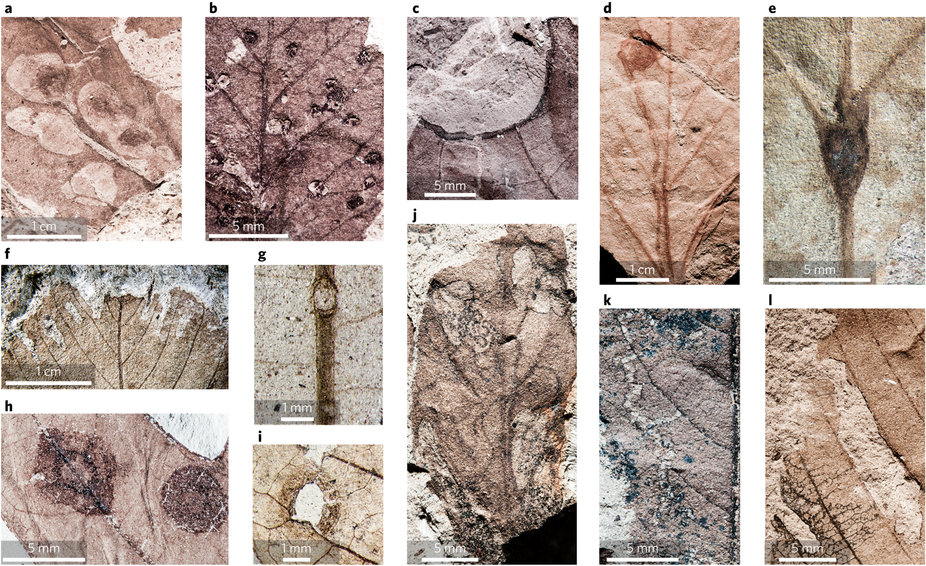Rapid recovery of Patagonian plant–insect associations after the end-Cretaceous extinction
The Southern Hemisphere may have provided biodiversity refugia after the Cretaceous/Palaeogene (K/Pg) mass extinction. However, few extinction and recovery studies have been conducted in the terrestrial realm using well-dated macrofossil sites that span the latest Cretaceous (late Maastrichtian) and early Palaeocene (Danian) outside western interior North America (WINA). Here, we analyse insect-feeding damage on 3,646 fossil leaves from the latest Maastrichtian and three time slices of the Danian in Chubut, Patagonia, Argentina (palaeolatitude approximately 50° S). We test the southern refugial hypothesis and the broader hypothesis that the extinction and recovery of insect herbivores, a central component of terrestrial food webs, differed substantially from WINA at locations far south of the Chicxulub impact structure in Mexico. We find greater insect-damage diversity in Patagonia than in WINA during both the Maastrichtian and Danian, indicating a previously unknown insect richness. As in WINA, the total diversity of Patagonian insect damage decreased from the Cretaceous to the Palaeocene, but recovery to pre-extinction levels occurred within approximately 4 Myr compared with approximately 9 Myr in WINA. As for WINA, there is no convincing evidence for survival of any of the diverse Cretaceous leaf miners in Patagonia, indicating a severe K/Pg extinction of host-specialized insects and no refugium. However, a striking difference from WINA is that diverse, novel leaf mines are present at all Danian sites, demonstrating a considerably more rapid recovery of specialized herbivores and terrestrial food webs. Our results support the emerging idea of large-scale geographic heterogeneity in extinction and recovery from the end-Cretaceous catastrophe.

a–l, Latest Cretaceous samples from the Lefipán Formation (a–c), and early Palaeocene samples8 from the Salamanca (d–i) and Peñas Coloradas (j–l) formations. a, Multiple, overlapping blotch mines containing centralized frass (DT299) on leaf morphotype LEF28 (LefW; MPEF-Pb 4776). b, Spheroidal galls with striated surfaces (DT303) on LEF2 (LefE; MPEF-Pb 4259). c, Margin feeding with thickened reaction tissue (DT12) on LEF23 (LefL; MPEF-Pb 4758). d, Serpentine mine with spheroidal terminal chamber (DT300) on Cissites patagonica (PL1; MPEF-Pb 6557). e, Elliptical gall positioned on the primary vein at the intersection with secondary veins (DT84) on Laurophyllum piatnitzkyi (PL1; MPEF-Pb 6555). f, Row of parallel-sided holes near the leaf margin (DT64) on Dryophyllum australis (PL1; MPEF-Pb 6560). g, Spheroidal galls with distinct outer rims positioned on the primary vein (DT117) of Cissites patagonica (PL2; MPEF-Pb 6567). h, Concentric rings of piercing and sucking marks surrounded by dark reaction tissue (DT118) on SA19 (PL2; MPEF-Pb 4072). i, Hole feeding surrounded by a wide rim of blotched reaction tissue (DT113) on SA43 (PL2; MPEF-Pb 6561). j, Serpentine mines that transition to blotch mines with internal, intestiniform trails (DT301) on Fagophyllum duseni (LF; MPEF-Pb 6547). k, Elongate, curvilinear patches of skeletonized tissue (DT20) on SA70 (LF; MPEF-Pb 6549). l, Deeply incised margin feeding damage (DT15) on Dryophyllum australis (LF; MPEF-Pb 6546). DT, damage type27 (new DTs defined in Supplementary Discussion).
Palaeontological evidence from both continental and marine deposits suggests that the Southern Hemisphere may have harboured biodiversity refugia in the wake of the bolide impact at Chicxulub, Mexico, 66.0 Myr ago (Ma)1,
Plant–insect interactions are fundamental components of terrestrial food webs, and their sensitivity to major environmental perturbations is well known from deep time as well as the modern world17,
Much less is known about the extinction and recovery of insect herbivores outside WINA. Late Palaeocene floras from Colombia are associated with low richness of plants and specialized insect-damage diversity as in Palaeocene WINA22, contrasting with high plant and insect-damage diversity on middle Palaeocene floras from France23 and Spitsbergen24. However, until now, no studies have investigated changes in insect-damage diversity based on terminal Cretaceous and early Palaeocene leaf floras from any non-WINA study area.
Full Text: http://www.nature.com/articles/s41559-016-0012
WFS,World Fossil Society,Riffin T Sajeev,Russel T sajeev



 November 7th, 2016
November 7th, 2016  Riffin
Riffin  Posted in
Posted in  Tags:
Tags: 